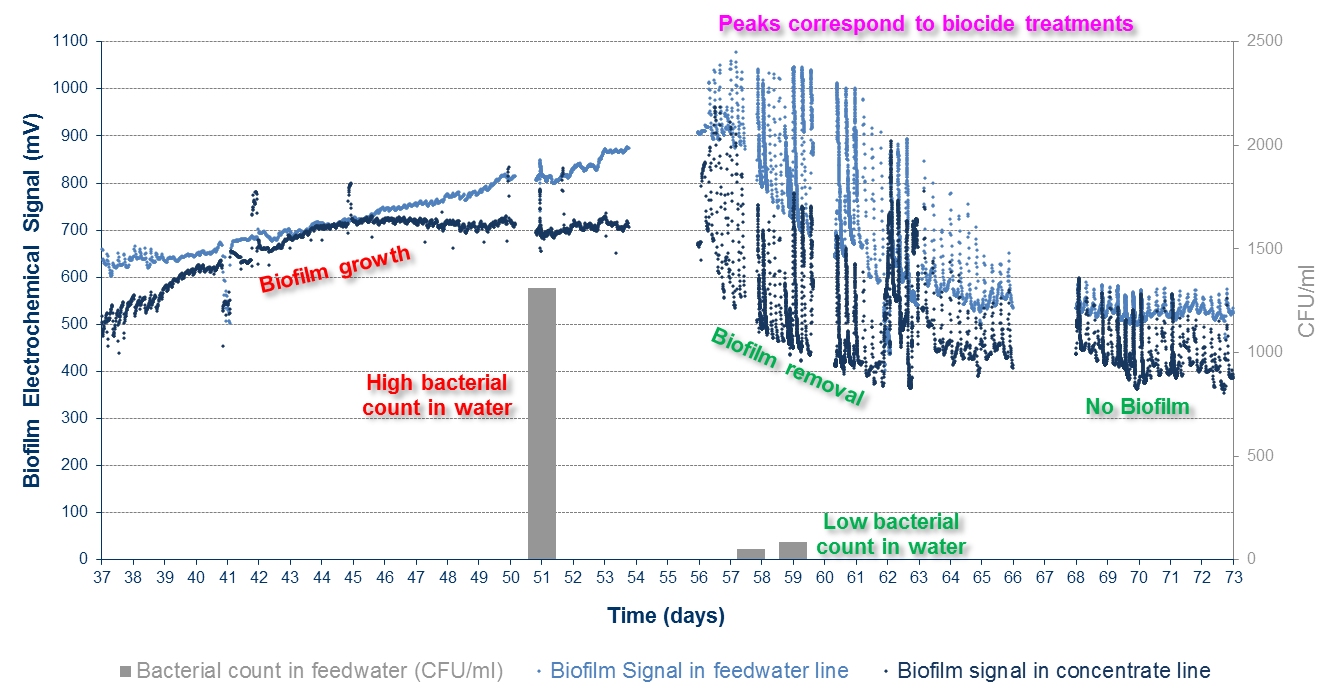Industrial reverse osmosis [Download this application case as PDF file]
Reverse osmosis (RO) is widely applied in the industry, to remove salts and other substances from process water. Bacterial growth on RO membranes can greatly reduce the efficiency of this process, thus large amounts of chemicals (usually known as “biocides”) are dosed in the water, to prevent the proliferation of bacteria. Many biocides are oxidizers, and their contact with RO membranes shall be avoided. For this reason, a tradeoff has to be achieved between the efficiency of the chemical treatment and the prevention of damages caused by such substances.
In this power plant, reverse osmosis was used to produce demineralized water for cooling of heat exchangers. Raw water was treated with a biocide, then passed ultrafiltration and was stored in a tank. RO was then applied (see the scheme below). One ALVIM Sensor was installed before RO, in the feedwater line, another one was installed in the concentrate line.


The Signal from the two ALVIM Sensors was acquired by the data acquisition system of the plant, along with the other data from the process. Laboratory analyses (CFU count) were periodically carried out, on water samples taken from different points.
It shall be noted that, while this kind of analysis provides a (rough) indication about the number of free-floating (planktonic) bacteria in the water, the ALVIM Sensor monitors the growth of biofilm, i.e. the layer of bacteria that forms on any surface in contact with water and other liquids. After the settlement of the first bacteria coming from water bulk, biofilm growth is no more related to the presence/number of free-floating bacteria. Indeed, the microorganisms settled on surfaces duplicate themselves, growing independently from the planktonic ones. More than 90% of bacteria live in biofilms (not free in the water), and these structures provide a much better protection from external agents, including biocides and other chemicals. For this reason, biofilm is up to 1000x more resistant to sanitation than free-floating bacteria.

The graph on the right shows the Signal of the two ALVIM Sensors (dark blue and light blue dots) and the results of lab analyses (gray column). Considering that ALVIM probes indicate:
- the dosage of oxidizing agents through a sharp and large increase in the Signal, and
- biofilm growth through a relatively slow increase in the Signal of 150 mV and more, with respect to the baseline value,
it can be noted that, after 45-50 days from the installation of the Sensors, biofilm growth was detected both in feedwater line and in concentrate line. Lab analyses on feedwater samples confirmed that there was a large number of bacteria in the water. All these data indicate that the biocide treatment was not effective in eliminating free-floating bacteria and biofilm. From day 56, the biocide treatment was adjusted, as it can be noted from the peaks in the ALVIM Signal. Bacterial count in water immediately decreased. In some days the treatment removed also biofilm, as it can be noted looking at ALVIM Signal. As previously mentioned, this bacterial layer is much more resistant to chemicals than free-floating microorganisms, so it is normal that it took longer to eliminate it, compared to planktonic bacteria.
The use of ALVIM Biofilm Sensors provided a reliable indication about bacterial growth in this water system, allowing to check and adjust biocide treatments.
Thanks to the ALVIM Technology it was possible to detect, on line and in real time:
- biofilm growth;
- effectiveness of biocide / need of a stronger cleaning;
- biofilm removal.
|
Do you have a similar problem with biofilm?
|





